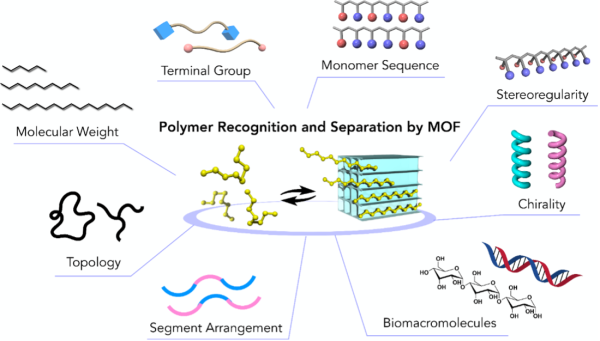Precise recognition of polymer structures occurs in biological systems using well-defined nanospaces for target biomacromolecules; for example, the genetic information on base sequences of mRNA is recognized with excellent precision in the ribosome. While artificial molecular recognition based on host−guest complexation has been established for small molecules, synthetic polymer recognition technology has yet to be developed. This is probably due to the large molecular sizes of polymeric compounds which result in the minute contribution of individual groups to overall structures and properties. Our group has developed a polymer recognition and separation technology based on MOFs, following our unexpected discovery that polymer chains may spontaneously penetrate into their pores. We envision that this technique will not only dramatically improve the purity of various polymers, but ultimately also achieve polymer recognition and separation based on differences at the single atom level in macromolecules.

Precise recognition and separation of polymers using MOFs
Selective sorting of polymers with different terminal groups using metal-organic frameworks
Nat. Commun. 2018, 9, 3635.
Recognition of Polymer Terminus by Metal–Organic Frameworks Enabling Chromatographic Separation of Polymers
J. Am. Chem. Soc. 2020, 142, 3701-3705.
Metal-Organic Frameworks for Macromolecular Recognition and Separation
Matter, 2020 3, 652-663.
Metal–Organic Frameworks for Practical Separation of Cyclic and Linear Polymers
Angew. Chem. Int. Ed. 2021, 60, 11830-11834.
Revisiting molecular adsorption: unconventional uptake of polymer chains from solution into sub-nanoporous media
Chem. Sci. 2021, 12, 12576-12586.
Mixed Metal–Organic Framework Stationary Phases for Liquid Chromatography
ACS Nano 2022, 16, 6771-6780.
An approach to MOFaxanes by threading ultralong polymers through metal–organic framework microcrystals
Nat. Commun. 2023, 14, 3241.
Decoding polymer chains via gated inclusion into flexible nanoporous crystals
Chem 2023, 9, 2817-2829.

